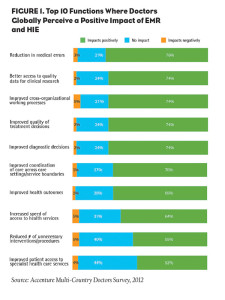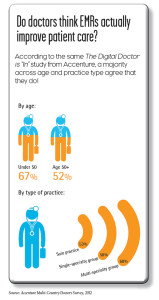Our clients and prospective clients understand the value of providing information to both the HCP and patient as the patient visit is occurring. They also report their pleasure with the role that in-office patient education programs or electronic co-pay offers can have on improving both first fill and ongoing adherence to therapy. But they also note that they still have questions about how HCPs use an EMR in their everyday practice. This article will shed some light on this area and better acquaint you with some ways physicians routinely use EMRs.
We’re basing our data on The Digital Doctor is “In,” a study of 3,700 physicians across eight countries including the U.S., released earlier this year by the consulting firm Accenture.
The U.S. is an e-Prescribing Nation
First, if you want to see e-prescribing as part of an EMR system, go to the U.S. where 65% of physicians surveyed reported having e-prescribing capabilities, up from 49% just one year earlier. This correlates with data recently released by Surescripts that showed 69% of U.S. physicians are e-prescribers. The U.S. leads in this area among all surveyed countries, with nations like Canada and England reporting e-prescribing rates of only 8% and 12%, respectively.
E-Notes and Electronically Populated Records Are Now the Norm
Another area in which the U.S. leads the world is in the use of electronic “chart notes” during patient visits, with 78% of surveyed physicians reporting this capability. U.S. physicians are also able to receive clinical results electronically that populate the patient’s EMR record more often than most of their global counterparts (62% can do this), with only Australia and Spain reporting a higher level of capability at 67% and 63%, respectively. We were also pleased to see that over half (57%) of all U.S. physicians can now electronically send order requests to labs, with only Spain (61%) and Singapore (56%) reporting similarly high levels.
But Electronic Communication with Patients is Universally Low
One area frequently cited by pharmaceutical marketers as a desired capability of EMRs is electronic communication between HCPs and patients. We understand the intuitive appeal of this, but as the Accenture data shows, this is not something to “count on” in the near future. Only 13% of U.S. physicians reported being able to electronically communicate with patients to support remote consultation and diagnostics, and no country reported having even 20% of physicians with this capability. Thus, the desire to send emails, texts and patient portal messages to patients—perhaps via brand supported educational programs—is just not a well-developed capability in today’s EMR systems.
We advise our clients to instead make use of capabilities that are more common, proven and scalable, such as using the EMR system to drive educational messages that are printed on-site and delivered to the patient by the HCP or office staff during the visit. We suspect that given the regulations released earlier this year, it will be quite some time before email, texting and similar vehicles become more available to marketers, but EMR messaging via printed communication will continue to grow.
Electronic Alerts to HCPs Becoming Common
Finally, we noted that electronic alerts and reminders to HCPs as they are seeing patients continues to grow in popularity, with the U.S. again reporting one of the highest rates at 45%. The data suggest to us that these on-screen messages will likely continue to be popular within EMRs, given their growing or steady use in all surveyed countries.
The Accenture study offers much more interesting information than we can discuss here, including the benefits that the use of EMRs can offer, which you can check out in Figure 1. You can also access the full report online at http://www.accenture.com/us-en/Pages/insight-digital-doctor-is-in.aspx. We also welcome your questions, and look forward to hearing from you about the ever-growing ways that EMR and e-Rx systems can improve HCP and patient education, and healthcare in general.
Sidebar: Do doctors think EMRs actually improve patient care?
According to the same The Digital Doctor is “In” study from Accenture, a majority across age and practice type agree that they do!






